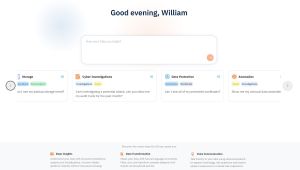News
Druva Launches MetaGraph to Advance Agentic Data Security
Druva today introduced Dru MetaGraph, which creates a secure, tenant-specific, graph-powered metadata layer to power real-time data intelligence. This move from the data security specialist builds directly on its introduction last month of DruAI Agents, an AI-driven expansion of its DruAI platform, representing the company's push into agentic AI systems for cyber resilience. And agentic AI, of course, is seen by many as the hottest area of advanced AI right now.
Unlocking Backup Metadata with MetaGraph
Dru MetaGraph aggregates all backup metadata--including file attributes, permissions, and identity information--into a secure, graph-based layer. It makes this data queryable and immediately usable for AI within the Druva platform, eliminating the need to extract, transform, and load metadata into external systems before analysis. According to Druva, this turns backup from a passive system of record into an active intelligence layer for security, compliance, and operational decision-making.
CEO and co-founder Jaspreet Singh said, "Backup has always been an untapped goldmine of intelligence, and Druva has steadily unlocked that potential with our growing family of AI agents. With Dru MetaGraph and the new DruAI agents, we're taking the next step and giving every team the ability to query and act on their metadata."
The MetaGraph's architecture enforces tenant-level isolation with end-to-end encryption and supports private retrieval-augmented generation (RAG) and isolated large language models (LLMs) to keep customer data secure while enabling contextual, AI-driven analysis.
 [Click on image for larger view.] DruAI Console (source: Druva).
[Click on image for larger view.] DruAI Console (source: Druva).
Expanding the DruAI Fleet of Agents
Coinciding with the MetaGraph launch, Druva introduced two new DruAI Agents: the Insights Agent and the Lifecycle Agent. These join the initial agents announced in August--Data Agents, Help Agents, and Action Agents--which were built on Amazon Bedrock AgentCore within AWS infrastructure to interpret user intent, analyze data, and take actions.
The new agents are designed to directly leverage the MetaGraph:
- Insights Agent -- Brings real-time intelligence into dashboards and reports, distilling complex data into prioritized insights. It highlights the most important risks, anomalies, and trends and recommends next steps, reducing the need to sift through numerous charts or alerts.
- Lifecycle Agent -- Enables organizations to analyze metadata across the entire data lifecycle, from creation to archival. Using natural language queries, it can identify stale or non-compliant data, locate orphaned accounts, and enforce retention policies at scale. It also supports turning queries into ongoing visualizations and dashboards for continual monitoring.
These agents work alongside the earlier DruAI Agents, which include:
- Data Agents -- Surface key signals and trends from telemetry, risk indicators, and historical data.
- Help Agents -- Guide users by troubleshooting problems, investigating incidents, and recommending next steps.
- Action Agents -- Execute tasks such as recovering workloads, creating protection policies, or adjusting retention settings to optimize cost.
Here's a table detailing all the agents and how they leverage MetaGraph:
| Agent Type | Primary Role | Leverages MetaGraph |
| Data Agents | Monitor backup metadata to uncover patterns, correlate risk indicators, and build historical baselines for analysis. | Yes (analyze metadata relationships and context) |
| Help Agents | Guide investigations by linking related telemetry events and suggesting targeted remediation steps. | Yes (use metadata context for investigations) |
| Action Agents | Execute automated recovery and policy operations triggered by real-time conditions and insight signals. | Yes (act on metadata-driven findings) |
| Insights Agent | Compile live signals into ranked summaries that spotlight critical risks, anomalies, and performance trends. | Yes (queries MetaGraph directly for real-time dashboards) |
| Lifecycle Agent | Track data from creation to archival to detect governance gaps and coordinate large-scale lifecycle actions. | Yes (queries MetaGraph for lifecycle-wide metadata) |
Industry analyst Johnny Yu of IDC commented: "Enterprises understand they have a collection of rich metadata captured in their backups, but they've struggled to make any use of it. By combining SaaS-native architecture, tenant-specific data graphs, and AI agents, Druva is addressing long-standing challenges of siloed metadata and complex pipelines, turning backup into a dynamic intelligence layer and shifting it from an insurance policy to playing an active role in resilience, compliance, and decision-making."
Operational Use Cases
By combining MetaGraph with DruAI Agents, Druva aims to accelerate workflows across cyber investigations, compliance, and operations. Example use cases include:
- Orchestrating full workload recovery with a single command, such as restoring an Amazon EC2 instance including its configuration, volumes, and networking.
- Instantly surfacing anomalies and suspicious patterns from telemetry to support faster decisions and responses.
- Allowing teams to ask natural-language questions like "Show me data that is not compliant to PCI retention adherence" and receive contextual, actionable results immediately.
- Providing customizable dashboards to monitor compliance, risk, or operational trends on an ongoing basis.
Security and Compliance Controls
All AI analysis remains within the Druva platform, and agents operate only on metadata, not the underlying customer data. Druva states that customer data never leaves its boundary and that each MetaGraph is isolated per tenant. The system is designed with zero-trust principles and complies with global standards including FedRAMP, SOC 2, and GDPR.
AWS's Rich Geraffo last month said that by leveraging Amazon Bedrock AgentCore, DruAI incorporates "autonomous agents that can proactively secure, recover and manage customer data," positioning the platform to deliver secure and scalable agentic solutions.
Commenting on today's announcement, Chris Robinson, an exec at Finance Factors, said, "Having all our backup metadata in one secure place has completely changed how fast my lean team can operate. Instead of stitching together manual reports, the MetaGraph and AI agents give us instant answers across risk, compliance, and operations."
Availability
The Insights Agent is generally available now, while the Lifecycle Agent will be available soon. Druva emphasized that both operate at no additional cost within the Druva Data Security Cloud platform.
About the Author
David Ramel is an editor and writer at Converge 360.